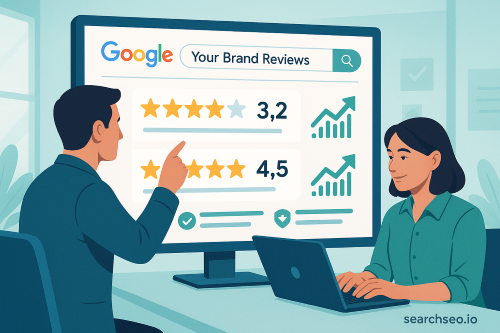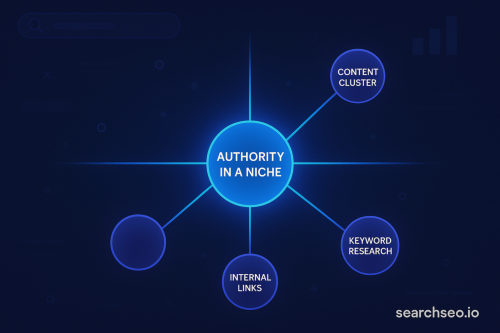“Near me” is no longer a novelty query, it’s a purchase trigger. In April 2025, analysts counted 1.5 billion “near me” searches every month, a 500 % jump in just a few years, with 28 % leading to an in-store or same-day purchase. On Google alone, 46 % of all searches now carry local intent, and 42 % of searchers tap a result inside the 3-Pack rather than scroll further.
This guide unpacks everything you need to win those ready-to-buy clicks from core ranking factors and multi-location scaling to AI-ready, voice-friendly content. By the end, you’ll have a field-tested playbook and a proven CTR booster, SearchSEO.io’s Google Business Profile (GBP) click-through manipulation engine to turn visibility into revenue.
What is a local SEO strategy?
A local SEO strategy is a systematic set of actions that improves a business’s visibility for geo-targeted queries across Google’s ecosystem—Maps, the Local Pack, organic blue links, and review panels. It differs from traditional SEO by prioritizing location, proximity, and offline engagement signals (calls, foot traffic, check-ins) rather than broad keyword rankings.

Snapshot of Google’s Local SERP
- Map Pack (a.k.a. 3-Pack): shows three businesses, a mini map, and “More places.”
- Local organic results: standard blue links influenced by traditional and local signals.
- Review panels & Justifications: snippets like “People mention patio seating” pull directly from reviews, posts, or website copy.
Why an effective local SEO strategy matters in 2025
1. Consumer behavior shifts
- Mobile dominance: 84 % of “near me” searches happen on a smartphone.
- Voice acceleration: 55 % of consumers now rely on voice assistants to locate nearby businesses.
- AI summaries: Google’s AI-Overviews and Siri’s on-device answers often cite GBP data first, shrinking organic real estate.
2. Business impact
- Higher click-through rate (CTR) in the Map Pack correlates with calls, driving-direction requests, and visits—metrics now surfaced in GBP Insights.
- Local intent searches show conversion rates up to 2× higher than non-local queries, according to Semrush’s 2024 local study.
3. Leveling the playing field
Smart SMBs can outrank national chains within micro-markets by mastering proximity, reviews, and click signals, especially when tools like SearchSEO.io simulate real-user engagement to lift CTR and dwell time.
Local SEO ranking factors you must master
Proximity, relevance & prominence
Google’s local algorithm still revolves around where the searcher is, how closely your listing matches the query, and the authority signals around your entity.
Entity signals
- NAP consistency: exact Name-Address-Phone across GBP, site, and citations.
- Primary & secondary categories: pick the revenue-driving category first.
- Attributes & services: fill every relevant field (wheelchair access, online appointments).
Behavioral & review signals
- CTR, dwell time, pogo-sticking: boosted by SearchSEO.io’s geo-targeted click pools.
- Review volume, velocity, and response rate: listings with 4.5★+ and timely owner replies dominate.
On-Page + technical signals
- Location pages with schema (LocalBusiness, FAQ), fast Core Web Vitals, and ADA-compliant UX (accessibility is now a ranking edge).
- Internal linking using city + service anchors to reinforce topical clusters.
Local link & citation signals
Backlinko’s 2025 guide notes authority from local newspapers, EDU sponsorships, and niche directories as critical trust votes. Build them deliberately instead of shotgun directory submissions.
Step-by-step local SEO strategy framework
Below is a nine-step blueprint for anyone asking how to create a local SEO strategy. Each step starts with a quick overview, then actions and metrics.
Step 1 – Audit your local presence
Start with a full Google Business Profile (GBP) audit, citation scan, and site crawl.
- Key metrics: Active listings count, crawl errors, missing NAP instances.
Step 2 – Local keyword research
Blend “service + city,” “near me,” and long-tail questions.
- Key metrics: Search volume, intent match rate (how many SERPs trigger a Map Pack).
Step 3 – Optimize Google business profile
Choose correct categories, upload geotagged photos, answer Q&A, and add the Products tab.
- Key metrics: GBP completeness score, photo views vs. competitors.
Step 4 – On-Page optimization for location pages
Craft unique H1/title, embed driving-direction schema, and keep load times <2.5 s.
- Key metrics: PageSpeed Insights, Core Web Vitals pass rate.
Step 5 – Build NAP consistency & citations
Submit to top-level aggregators (Data Axle, Neustar Localeze) and niche directories.
- Key metrics: Citation accuracy %, duplicate suppression count.
Step 6 – Acquire local links & PR
Sponsor community events, pitch local journalists, and pursue EDU resource pages.
- Key metrics: New referring domains, average domain rating (DR).
Step 7 – Generate & leverage reviews
Automate SMS/email requests post-purchase; respond to every review and deploy a crisis-response template for review attacks.
- Key metrics: Average rating, review velocity (reviews/month).
Step 8 – Publish hyper-local content
Create neighborhood guides, “Best brunch in {Area}” posts, and customer spotlight videos.
- Key metrics: Engagement (time on page), local SERP wins (impressions, clicks).
Step 9 – Track, analyze & refine
Use Google Search Console, GBP Insights, call-tracking numbers, and UTM tagging.
- Key metrics: Direction requests, calls, conversions vs. baseline.
Pro tip: Sync these KPIs into a real-time dashboard and A/B-test title tweaks with SearchSEO.io’s CTR splitter to validate impact fast.
Advanced tactics for multi-location & service-area businesses
1. Use Subfolders, Not Subdomains
Keep location pages under /locations/city/ for stronger link equity and domain authority.
2. Build Programmatic Location Pages
Scale with dynamic blocks like testimonials, FAQs, and reviews to prevent thin content.
3. Add Dynamic Driving-Direction Schema
Auto-fill the hasMap property with UTM-tagged URLs to track real tap-throughs from Google Maps.
4. Combine LSA and PPL Campaigns
Blend Local Service Ads with Pay-Per-Lead models to dominate both paid and organic local visibility.
5. Integrate First-Party Data
Use CRM or CDP insights to personalize offers by ZIP code and link SEO performance to revenue.
These tactics help multi-location and service-area businesses scale efficiently, improve engagement, and turn local search traffic into real customers.
Content Pillars for a winning local SEO content strategy
City & neighborhood landing pages
Write unique intros, embed local landmarks in alt-text, and feature staff photos taken onsite.
“Best of” & “Cost” blog posts
Transparent pricing or curated “Top 10 {Service} in {City}” earns featured snippets and showcases E-E-A-T.
Event & community news hubs
Live-update festival dates, road closures, or charity drives to earn natural backlinks.
Short-form video & YouTube shorts
Geo-tagged 60-second clips (“Walk-through of our new {Location} showroom”) often surface inside the Knowledge Panel.
Voice & ai-assistant optimized FAQs
Use conversational Q&A (<h3> with the exact question) so Google’s AI-Overviews and Alexa can quote you verbatim.
Measuring success: local SEO KPIs & reporting
- GBP Insights: track calls, website clicks, direction requests.
- UTM tagging: segment Map Pack vs. organic traffic in GA4.
- Call tracking & store-visit data: attribute ROI down to ad group or keyword.
- Dashboard cadence: monthly for ops tweaks, quarterly for strategic pivots.
- Narrative reporting: translate “+22 % CTR” into “184 extra customers last quarter” for executives.
Common mistakes that tank local SEO efforts
- Stuffing keywords into your GBP name (“Joe’s Pizza Best Brooklyn Slice”).
- Letting NAP inconsistencies linger across Yelp, Facebook, and data aggregators.
- Spinning duplicate location pages with only the city name swapped.
- Ignoring or deleting negative reviews—instead, respond within 48 hours.
- Over-optimizing anchor text in local link building (diversify with branded or generic anchors).
Ready to amplify your local visibility?
Building a winning local SEO strategy in 2025 means mastering Google’s core trio—proximity, relevance, prominence—while feeding the algorithm fresh behavioral cues, authoritative content, and frictionless user experiences. The process never truly ends: audit, optimize, and refine as consumer behavior evolves toward mobile, voice, and AI answers.
Dominate the map, own the moment, and turn every “near me” into “right now.”


.svg)

.svg)
%201.png)








.svg)